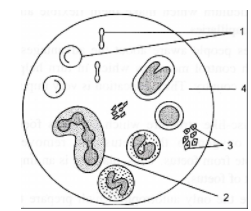
Given is a diagram of a human blood smear. Study the diagram and answer the question that follows.
Components numbered 1 do not have certain organelles but are very efficient in their function. Explain.


Answer
480.9k+ views
Hint: There are four components of blood smear that are numbered 1 to 4 in this diagram of human blood smear. 1) Red blood corpuscles, 2) Neutrophil, 3) Blood platelets, 4) Blood plasma. These are the components of the blood smear performing specific functions in the blood and helps in transport of food and gases to every part of the body.
Complete answer:
The component number 1 is Red blood corpuscles (RBCs) do not have nucleus and ribosomes or mitochondria and are called denucleated. The major function of the RBC is to transport oxygen from our lungs to the cells of the body and in return bring back carbon dioxide back to our lungs which is exhaled out of the body. Thus, RBCs are very efficient in their function and help in diffusion of oxygen and carbon dioxide across the RBC’s plasma membrane.
Neutrophils are polymorphonuclear and phagocytic leukocytes that comprise the first line of host immune response against invading pathogens. They also provide immunity during tissue injury and attack by any microbe.
Blood platelets help in coagulation of the blood. It reacts to the injury by clumping thereby initiating a blood clot while bleeding.
Blood plasma is a yellow liquid fluid that holds the blood cells of whole blood in a suspension. It is a liquid part of blood that carries cells and proteins throughout the body.
Note: Red Blood Corpuscles contain hemoglobin molecules, which is an iron-containing molecule that can bind oxygen and is responsible for red color of the blood.
Complete answer:
The component number 1 is Red blood corpuscles (RBCs) do not have nucleus and ribosomes or mitochondria and are called denucleated. The major function of the RBC is to transport oxygen from our lungs to the cells of the body and in return bring back carbon dioxide back to our lungs which is exhaled out of the body. Thus, RBCs are very efficient in their function and help in diffusion of oxygen and carbon dioxide across the RBC’s plasma membrane.
Neutrophils are polymorphonuclear and phagocytic leukocytes that comprise the first line of host immune response against invading pathogens. They also provide immunity during tissue injury and attack by any microbe.
Blood platelets help in coagulation of the blood. It reacts to the injury by clumping thereby initiating a blood clot while bleeding.
Blood plasma is a yellow liquid fluid that holds the blood cells of whole blood in a suspension. It is a liquid part of blood that carries cells and proteins throughout the body.
Note: Red Blood Corpuscles contain hemoglobin molecules, which is an iron-containing molecule that can bind oxygen and is responsible for red color of the blood.
Recently Updated Pages
Master Class 11 Accountancy: Engaging Questions & Answers for Success

Glucose when reduced with HI and red Phosphorus gives class 11 chemistry CBSE

The highest possible oxidation states of Uranium and class 11 chemistry CBSE

Find the value of x if the mode of the following data class 11 maths CBSE

Which of the following can be used in the Friedel Crafts class 11 chemistry CBSE

A sphere of mass 40 kg is attracted by a second sphere class 11 physics CBSE

Trending doubts
Define least count of vernier callipers How do you class 11 physics CBSE

The combining capacity of an element is known as i class 11 chemistry CBSE

Proton was discovered by A Thomson B Rutherford C Chadwick class 11 chemistry CBSE

Find the image of the point 38 about the line x+3y class 11 maths CBSE

Can anyone list 10 advantages and disadvantages of friction

Distinguish between Mitosis and Meiosis class 11 biology CBSE




